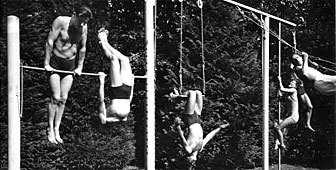Memories of Monte Verita

Ticino was for a long time home to a community of artists, who sought to escape the rapid modernisation of Europe. Monte Verita, as it was known, left a deep mark on the arts in western Europe in the first half of the 20th century.
Nearly every famous artist of the period spent time in the community on Monte Verita, overlooking the lakeside town of Ascona in canton Ticino.
It began as a “back-to-nature” movement in reaction to the rapid industrialisation of Europe. But in its heyday from 1900 until the outbreak of the Second World War, Monte Verita became a haven for those seeking alternative lifestyles.
The anarchists who founded the community were followed by vegetarians, Dadaists and Expressionists. Among them were also nudists, pacifists, Freemasons, feminists, Theosophists and bohemians, many of them artists, dancers or writers seeking calm and inspiration.
Some lived on Monte Verita, while others just passed through. But few remained unaffected by the experience.
Among those who spent time at Monte Verita were the feminist and pianist, Ida Hofmann, the writer Hermann Hesse, and the Swiss Expressionist painter, Hans Arp.
“Although no lasting and distinctive art form came into being on Monte Verita,” says researcher Christine Eggenberg, “the influence of this offbeat resort in southern Switzerland is reflected in nearly every work of fiction or art created during this period.”
Eggenberg says the community was the cradle of German interpretational dance under Rudolf von Laban, whose theories helped pave the way for the creation of modern dance.
She says Monte Verita was also an important meeting place for Dadaists. Many of them were active in Zurich, but met in the mountains above Ascona for “happenings” such as choral festivals, choreographed verse recitals and masquerades.
Locals tolerated the community, and seem to have regarded it as something of a lunatic asylum. For a while it became such an attraction that Henri Oedenkoven, who owned Monte Verita for many years, charged a fee to allow locals into the grounds to watch the inmates.
The community dwindled after 1940 and disintegrated totally in 1958, leaving the buildings to fall into disrepair. They have now been restored, and some parts turned into a museum.
swissinfo

In compliance with the JTI standards
More: SWI swissinfo.ch certified by the Journalism Trust Initiative
You can find an overview of ongoing debates with our journalists here. Please join us!
If you want to start a conversation about a topic raised in this article or want to report factual errors, email us at english@swissinfo.ch.